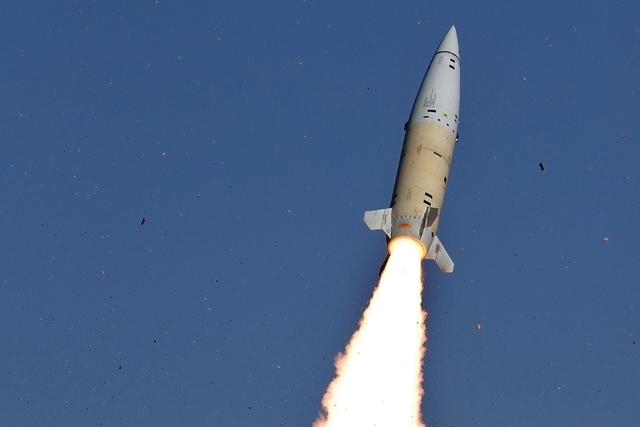Defence
All About US' ATACMS Missile That Ukraine Recently Successfully Used Against Russia, And Does India Have Any Comparable System?

Lockheed Martin Advanced Tactical Missile System (ATACMS). (Image via Lockheed Martin)
The United States has supplied the much-vaunted Advanced Tactical Missile Systems (ATACMS) to Ukraine, that the Ukrainian forces used to successfully strike a Russian air base at Berdyansk.
This airstrike reportedly destroyed multiple Russian helicopters, an ammunition dump, and an air defence system.
Ukrainians also struck another Russian air base at Luhansk, approximately 100 kilometres from the frontline, causing substantial damage to the airfield.
Following the attack, Ukrainian President Volodymyr Zelensky stated that the ATACMS had performed well, hitting their targets extremely accurately.
He stated, "They have performed very accurately. ATACMS have proven themselves."
Previously, the Biden administration had refused to supply ATACMS missiles to Ukraine.
However, according to CNN, the US administration secretly supplied 20 missiles to keep the element of surprise and prevent Russia from moving its equipment out of the ATACMS range.
The Russian Defense Ministry subsequently stated they had shot down five ATACMS missiles and four Ground Launched Small Diameter bombs (GL-SDB).
In this report, we delve into the capabilities of ATACMS missiles and explore whether India possesses a comparable missile to ATACMS.
ATACMS
As already stated ATACMS stands for advanced tactical missile system that is developed by US-weapons manufacturer — Lockheed Martin.
First tested in 1988, the missile is capable of striking targets at a maximum range of 300 kilometres and was successfully used in 1991 during Operation Desert Storm against Iraq.
The 4-meter-long and 610-mm-diameter missile can be fired from the M142 High Mobility Artillery Rocket Systems (HIMARS) launchers, donated to Ukraine by the US, or by M270 tracked MLRS launcher.
Each HIMARS launcher can fire a single ATACMS missile, while the M270 launcher can launch two. These missiles are used to destroy high-value targets in the enemy's rear.
The missile is powered by a solid-fueled rocket motor and is guided by the Inertial Navigation System (INS) and Global Positioning System (GPS).
The missile can carry hundreds of submunitions and bomblets (M39 variant) that can destroy thin-skinned targets like vehicles and troops, in addition to using penetrating unitary warheads (M48, M57, and M57E1 variants) for bunker busting.
The ATACMS M39 variant was used in the Ukrainian attack on the Berdyansk and Luhansk airfields.
Russians also posted pictures of debris that suggest that the missile was an older variant produced in 1996, with a maximum range capped at 165 kilometres ensure it could not reach targets within Russia itself.
Does India Have A Comparable Missile?
India has multiple missiles capable of hitting targets at ranges of around 300 kilometres, but it does not posses a like-to-like analogous to the ATACMS.
The DRDO-developed Prithvi short-range tactical ballistic missile, with a maximum range of 350 kilometres, shares a comparable range. However, they are not in the same class.
The Prithvi uses a liquid-fueled motor to power the missile, whereas the ATACMS uses a solid-fueled rocket motor.
A more comparable missile is the in-development Pralay missile, also powered by a solid-fueled rocket motor, with a strike range of 350-500 kilometres — 200 kilometres more than the publicly known range of ATACMS.
However, the Pralay missile is a newer, more capable missile than the ATACMS, with a longer range and a quasi-ballistic trajectory, making it harder to intercept by air defense systems.
The Indian armed forces employ the BrahMos supersonic cruise missile to strike targets at ranges of 300 kilometres.
The Indo-Russian supersonic cruise missile has a maximum range of 290 kilometres. India has developed an even longer-range version of the missile, capable of striking targets up to 450 to 500 kilometres.
Nevertheless, the BrahMos missile is incomparable to the ATACMS missile, as it is a cruise missile powered by a ramjet engine throughout its flight.
In contrast, the ATACMS is a ballistic missile with a rocket motor that burns out in the initial phase, providing the missile with the necessary speed, height, and trajectory.
Support Swarajya's 50 Ground Reports Project & Sponsor A Story
Every general election Swarajya does a 50 ground reports project.
Aimed only at serious readers and those who appreciate the nuances of political undercurrents, the project provides a sense of India's electoral landscape. As you know, these reports are produced after considerable investment of travel, time and effort on the ground.
This time too we've kicked off the project in style and have covered over 30 constituencies already. If you're someone who appreciates such work and have enjoyed our coverage please consider sponsoring a ground report for just Rs 2999 to Rs 19,999 - it goes a long way in helping us produce more quality reportage.
You can also back this project by becoming a subscriber for as little as Rs 999 - so do click on this links and choose a plan that suits you and back us.
Click below to contribute.
Latest